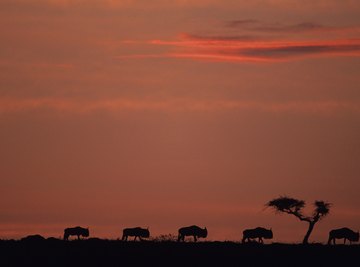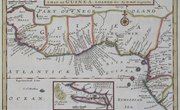
When thinking about the world’s biomes, the tropical rain forest and the savanna often come to mind. There is also, however, a distinguished biome known as the tropical scrub forest biome. Home to a number of unique species, it is distinct in several ways, and governments must carefully consider its conservation.
What Is the Tropical Scrub Forest Biome?
The tropical scrub forest biomes of the world are diverse forests typically with dry deciduous forest and scrub plant communities. They have a significant dry season of four to seven months per year. The deciduous species lose their leaves during the dry season. The longer the dry season of a tropical scrub forest, the more deciduous plants there are.
This biome has high species richness and possibly more plant species than the Amazon rainforest. While tropical rainforests garner considerable attention in conservation circles, the tropical scrub dry forests of the world are endangered. Learning more about them could help with conservation efforts.
Tropical scrub forests can be found throughout the world, poleward from 20 degrees latitude. Northeastern Brazil contains the most extensive parts of such forests. Argentina, Bolivia, Paraguay and Peru all have stretches of this biome. North and Central America host these dry forests from western Mexico to parts of Costa Rica, Panama, Belize and the American Southwest.
In Africa, tropical dry forests exist in parts of Gabon, Cameroon and the Democratic Republic of the Congo, as well as in portions of Ghana, Cote d’Ivoire and Liberia. In Asia, the Deccan Plateau and Western Ghats of India, as well as parts of Bangladesh, house these forests. In the past, large swaths of tropical dry forests once covered Pakistan.
Distinguishing Tropical Scrub Forests From Savannas and Rain Forests
Tropical scrub forests differ from tropical rain forests and savannas in several ways. One is the amount of precipitation received, and another is the prevalence of fire. In contrast to savannas, most tropical scrub forests have closed canopies from up to 15 meters in height. This canopy suppresses both grass growth and fires.
Tropical savannas are comprised of grasses and experience fires. The tropical scrub forest does not have the same biomass level as a savanna, so regular fires are not prevalent.
Compared to tropical rain forests, tropical scrub forests receive far less rainfall annually. The dry deciduous forests and scrubs possess smaller, thicker leaves and bark than trees in a tropical rainforest. Tropical dry forests also experience drier conditions than savannas.
Types of Plants in the Scrub Forest
Plant diversity abounds in the tropical scrub forests of the world. There are fewer epiphytes than in a tropical rainforest, but woody plants flourish. Often the scrub vegetation contains thorns or resinous leaves. Trees that store water thrive in the scrub forests, such as baobabs in mainland Africa and Madagascar or South America's Brazilian bottle trees.
In American chaparral regions, water-storing plants such as cacti and bromeliads are not uncommon. In Africa, euphorbias flourish. Plants flower according to the season in which their pollinators arrive: birds in the drier season, insects in the wetter season.
In Pakistan, the tropical dry thorn forest is prevalent, hosting Prosopis cineraria and Salvadora oleoides. Called 'rakhs,' these woodlands once comprised much of the Indus basin. They hosted grazing animals and provided firewood and other resources for people and animals. Prosopis alone is a crucial plant, as it is nitrogen-fixing, adding to soil fertility.
Types of Animals in a Tropical Scrub Forest
The seasonally dry scrub forests of the world play host to many kinds of animals, ranking only behind tropical rainforests in their diversity. Insects such as ants and termites abound. Primates, rodents, anteaters, aardvarks, langurs, jaguars, tigers, mongooses and foragers like elephants shelter among tropical dry forests. Other fauna that reside or migrate through tropical scrub forests include blackbuck, gaur, wild dogs and various birds.
You might wonder how animals cope with the unique aspects of a tropical scrub forest. One method is migration, based on the rainy or dry season. Another adaptation is storing fat or food.
Scrub Forest and Chaparral Soil Characteristics
The soil of a tropical scrub forest tends to be arid due to the lack of rainfall and prevalence of evaporation. Soils in this biome are well-drained, and xeric soils are often found on old alluvial plains. In areas of rocky soils, thorn scrub vegetation proliferates.
Plants such as those in the genus Prosopis provide nitrogen-fixing of the soil. Other plants, such as Salvadora oleoides, contribute leaf matter and possess strong root systems, preventing soil erosion. Because these dry forests have deciduous plants, leaf matter aids soil fertility. Many of these regions are downwind of volcanic mountain ranges, which help enrich soil fertility.
The Importance of the Tropical Scrub Forest Biome
In addition to providing crucial habitats for various plants and animals, people also benefit from the scrub forests of the world. Plants in this biome yield food, lumber, clothing, medicines and many more benefits to humanity. Common crops in this biome include corn, cotton, rice and beans. Seeds provide essential food sources for livestock.
Scrub vegetation provides shade and shelter. Fruits and leaves feed all manner of wildlife. Flowers provide nectar for both birds and insects. Bark provides ingredients for astringents or dyes. The scrub forest is also important for agricultural communities and the spiritual and cultural well-being of many people worldwide.
Scrub vegetation in regions such as the Deccan Plateau has been dramatically altered over time by human intervention and heavy livestock grazing, leading to more thorn scrub in a previously broader tropical dry forest.
Preserving the tropical scrub forest biome requires a global effort. Botanic gardens can teach people about the unique plant life of these scrub forests and preserve seeds and cultivars for habitat restoration. Global environmental change threatens this unique biome, so education about this biome is crucial.
References
- Biodiversity: Tropical Dry Forests - The Most Endangered Major Tropical Ecosystem
- World Wildlife Fund: Southern Asia: Southern India Into the Island of Sri Lanka
- Frontiers in Ecology and Evolution: Inserting Tropical Dry Forests Into the Discussion on Biome Transitions in the Tropics
- Botanic Gardens Conservation International: Dry Woodlands in Pakistan’s Punjab Province – Piloting Restoration of Unique Yet Vanishing Natural Assets
About the Author
J. Dianne Dotson is a science writer with a degree in zoology/ecology and evolutionary biology. She spent nine years working in laboratory and clinical research. A lifelong writer, Dianne is also a content manager and science fiction and fantasy novelist. Dianne features science as well as writing topics on her website, jdiannedotson.com.
Photo Credits
Anup Shah/Digital Vision/Getty Images
